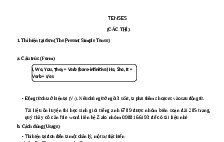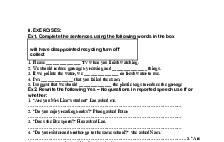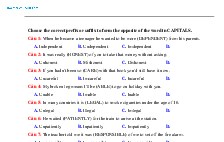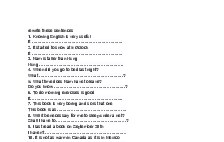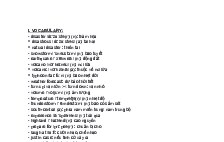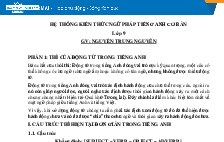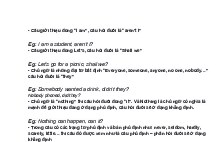Từ vựng và ngữ pháp Tiếng Anh 9 Unit 9
Nội dung tài liệu
Tải xuốngCác tài liệu liên quan
-
![20 chuyên đề bồi dưỡng HSG THCS môn Tiếng Anh]()
-
![Các chuyên đề bồi dưỡng HSG Tiếng Anh THCS]()
-
![33 Đề giáo viên dạy giỏi môn anh]()
-
![Câu trực tiếp & Câu gián tiếp]()
-
![Trắc nghiệm tính từ THPTQG môn Tiếng Anh]()
-
![Tài liệu ôn thi HSG Tiếng Anh 9.]()
-
![Từ vựng và ngữ pháp Tiếng Anh 9 Unit 9]()
-
![Hệ thống kiến thức cơ bản về thì, động từ trong Tiếng Anh]()
-
![NATIONAL UNIVERSITY OF HO CHI MINH CITY.docx]()
-
![Câu hỏi đuôi dạng đặc biệt]()
Có thể bạn quan tâm
Thông tin tài liệu
I. VOCABULARY: - disaster /dɪˈzɑːstə(r)/ (n): thảm họa + disastrous /dɪˈzɑːstrəs/ (a): tai hại + natural disaster : thiên tai - snowstorm /ˈsnəʊstɔːm/ (n): bão tuyết - earthquake /ˈɜːθkweɪk/ (n): động đất - volcano /vɒlˈkeɪnəʊ/ (n): núi lửa + volcanic /vɒlˈkænɪk/(a): thuộc về núi lửa + typhoon /taɪˈfuːn/ (n): bão nhiệt đới - weather forecast: dự báo thời tiết - turn up: vặn lớn >< turn down: vặn nhỏ - volume /ˈvɒljuːm/ (n): âm lượng - temperature /ˈtemprətʃə(r)/ (n): nhiệt độ - thunderstorm /ˈθʌndəstɔːm/ (n): bão có sấm sét - south-central (a): phía nam miền trung/ nam trung bộ - experience /ɪkˈspɪəriəns/ (v): trải qua - highland /ˈhaɪlənd/(n): cao nguyên - prepare for /prɪˈpeə(r)/ : chuẩn bị cho - laugh at /lɑːf/: cười nhạo, chế nhạo - just in case: nếu tình cờ xảy ra - canned food: thức ăn đóng hộp - candle /ˈkændl/ (n): nến - match /mætʃ/ (n): diêm quẹt - imagine /ɪˈmædʒɪn/ (v): tưởng tượng - share /ʃeə(r)/ (v): chia sẻ - support /səˈpɔːt/ (v): ủng hộ - ladder /ˈlædə(r)/(n): cái thang - blanket /ˈblæŋkɪt/ (n): chăn mền - bucket /ˈbʌkɪt/ (n): cái xô - power cut : cúp điện - Pacific Rim: vành đai Thái Bình Dương - tidal wave = tsunami /tsuːˈnɑːmi/ :sóng thần - abrupt /əˈbrʌpt/ (a): thình lình - shift /ʃɪft/ (n): sự chuyển dịch - underwater /ˌʌndəˈwɔːtə(r)/(a): ở dưới nước - movement /ˈmuːvmənt/ (n): sự chuyển động - hurricane /ˈhʌrɪkən/ (n): bão - cyclone /ˈsaɪkləʊn/ (n): cơn lốc - erupt /ɪˈrʌpt/ (v): phun + eruption (n): sự phun trào - predict /prɪˈdɪkt/ (v): đoán trước + prediction (n): sự đoán trước - tornado /tɔːˈneɪdəʊ/ (n): bão xoáy - funnel-shaped (a): có hình phễu - suck up: hút - path/pɑːθ/ (n): đường đi - baby carriage /ˈkærɪdʒ/: xe nôi II. GRAMMAR: I. Defining relative clauses (without commas) + Defining relative clauses give us the necessary information to know which person or thing is referred to. E.g: The boy who is sitting next to Angela is from China. + In defining relative clauses, that is often used instead of which after superlatives, all, every(thing), nothing, any(thing), some(thing), none, little, few, much and only. E.g: It is the best film that I have ever seen. The only thing that matters is to tell the truth. + If it is the object, the relative pronoun is often left out. E.g: The girl who I have just talked to is very kind --> The girl I have just talked to is very kind. II. Non – defining relative clauses (with commas) + Non – defining relative clauses give extra information which is not really necessary. E.g: My uncle, who is a teacher, lives in Australia. + That cannot be used, and the relative pronoun cannot be left out. A comma must be used before this kind of relative clause, and also after it if it is in the middle of a sentence. E.g: Hawaii, which consists of eight principal islands, is a favorite vacation spot.



